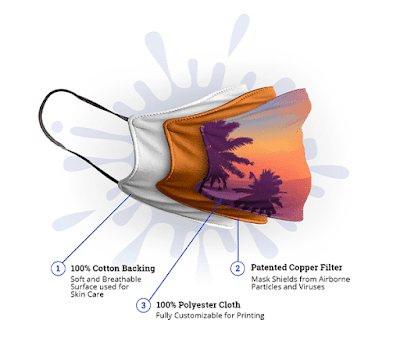On June 14, 1777, the Continental Congress passed an act establishing an official flag for the new nation. The resolution stated: “Resolved, that the flag of the United States be thirteen stripes, alternate red and white; that the union be thirteen stars, white in a blue field, representing a new constellation." On Aug. 3, 1949, President Harry S. Truman officially declared June 14 as Flag Day.
The history of our flag is as fascinating as that of the American Republic itself. It has survived battles, inspired songs and evolved in response to the growth of the country it represents. Topmago has published a new Fabric Face Mask at our store, check it out with the coming given details.
American Flag Eagle Fabric Face Mask
The Fabric Face Mask is just like an American Flag itself. On the American Flag, there should be the America National Symbol, the Eagle. Let's name it the American Flag Eagle Fabric Face Mask. Check now at Topmago !
 |
| American Flag Eagle Fabric Face Mask |
 |
| American Flag Eagle Fabric Face Mask |
Topmago wish you a good time shopping with American Flag Eagle Fabric Face Mask at our store.
Some Interesting Information of The American Flag
Inspiration
After a British bombardment, amateur poet Francis Scott Key was so inspired by the sight of the American flag still flying over Baltimore's Fort McHenry that he wrote "The Star-Spangled Banner" on Sept. 14, 1814. It officially became our national anthem in 1931.
In 1892, the flag inspired James B. Upham and Francis Bellamy to write The Pledge of Allegiance. It was first published in a magazine called The Youth's Companion.
On Distant Shores
In 1909, Robert Peary placed an American flag, sewn by his wife, at the North Pole. He also left pieces of another flag along the way. It is the only time a person has been honored for cutting the flag.
In 1963, Barry Bishop placed the American flag on top of Mount Everest.
In July 1969, the American flag was "flown" in space when Neil Armstrong placed it on the moon. Flags were placed on the lunar surface on each of six manned landings during the Apollo program.
The first time the American flag was flown overseas on a foreign fort was in Libya, over Fort Derne, on the shores of Tripoli in 1805.
Displaying the Stars and Stripes
The flag is usually displayed from sunrise to sunset. It should be raised briskly and lowered ceremoniously. In inclement weather, the flag should not be flown.
The flag should be displayed daily and on all holidays, weather permitting, on or near the main administration buildings of all public institutions. It should also be displayed in or near every polling place on election days and in or near every schoolhouse during school days.
When displayed flat against a wall or a window, or in a vertical orientation, the “union” field of stars should be uppermost and to the left of the observer.
When the flag is raised or lowered as part of a ceremony, and as it passes by in parade or review, everyone, except those in uniform, should face the flag with the right hand over the heart.
The U.S. flag should never be dipped toward any person or object, nor should the flag ever touch anything beneath it.
No comments:
Post a Comment